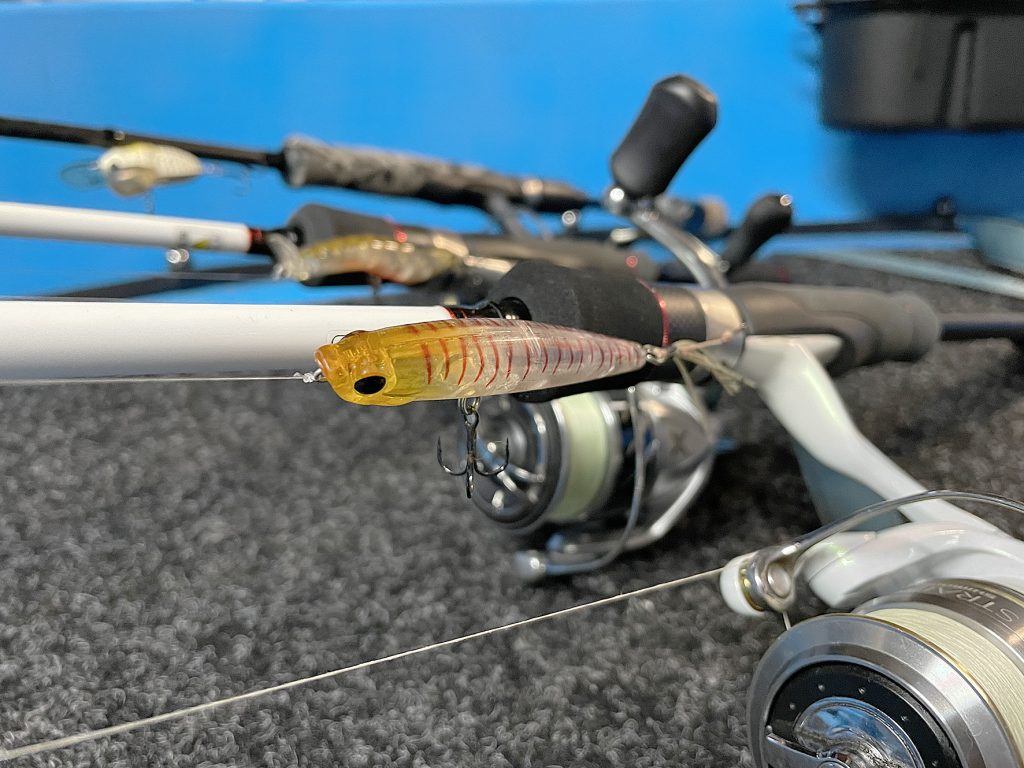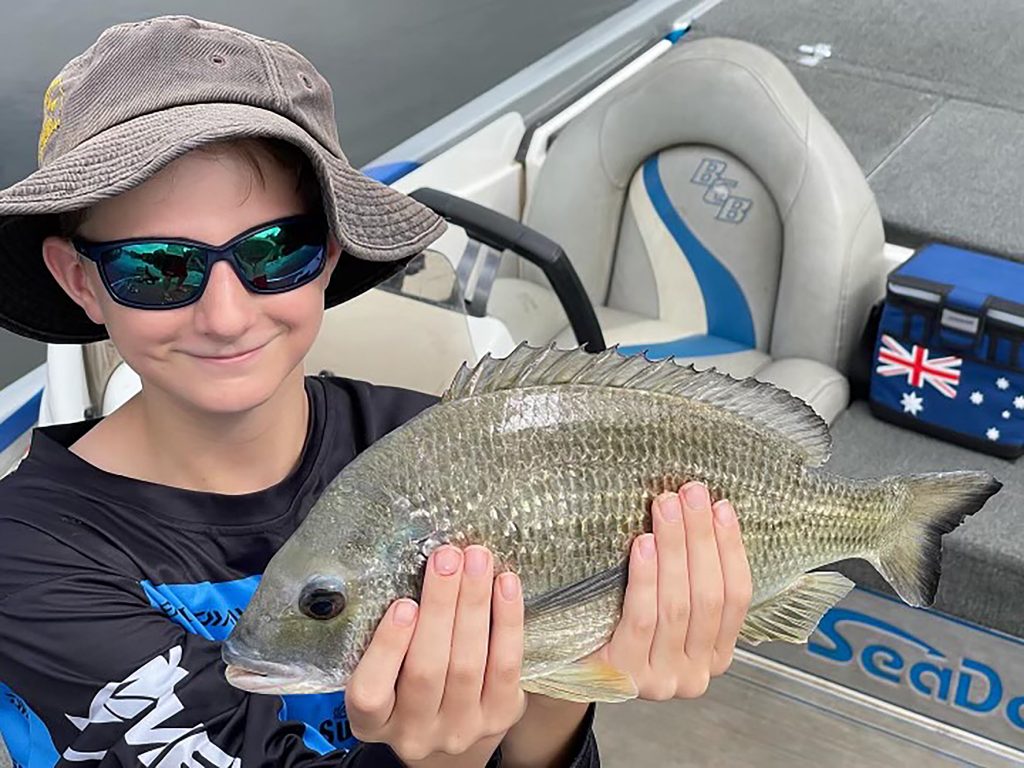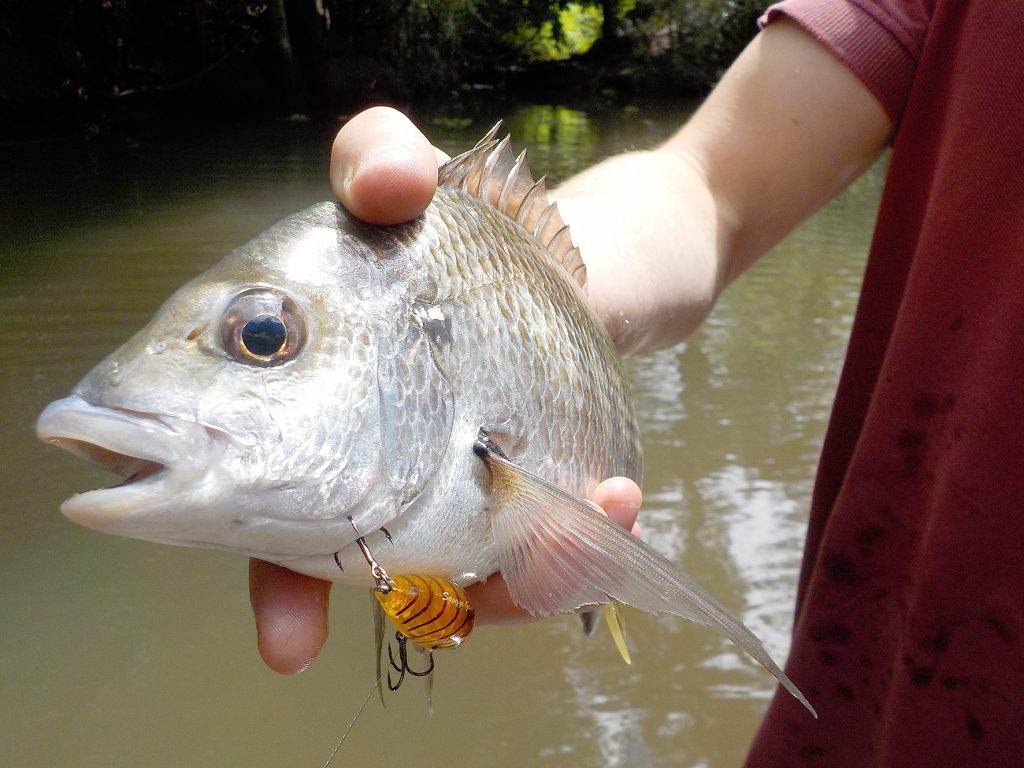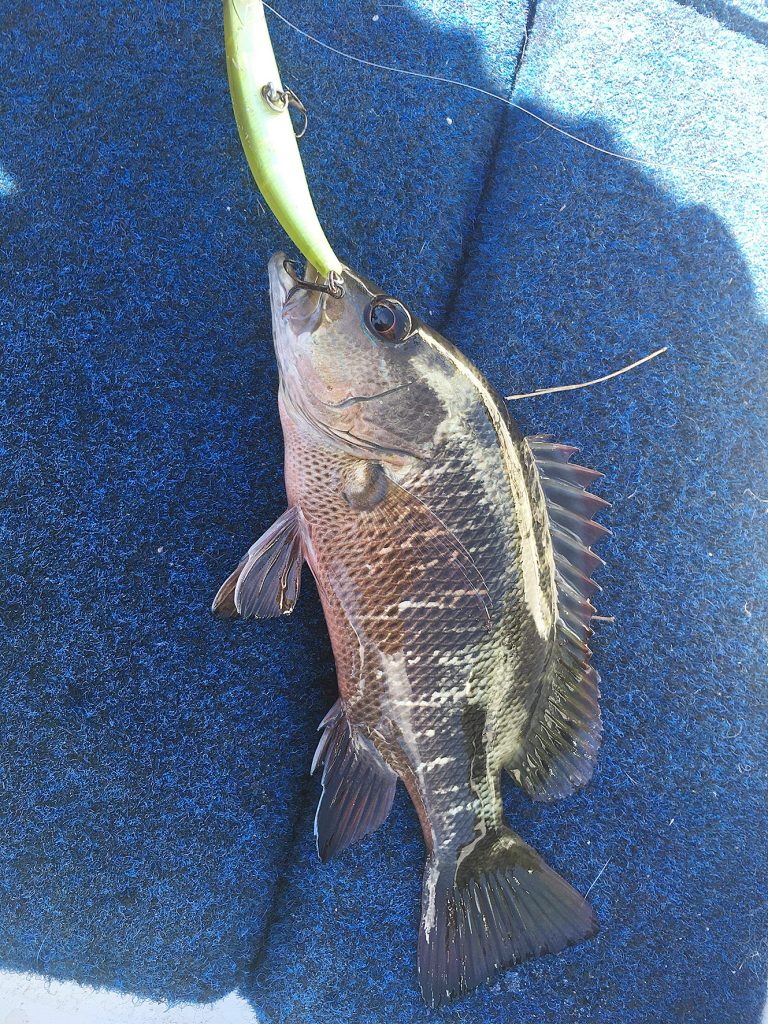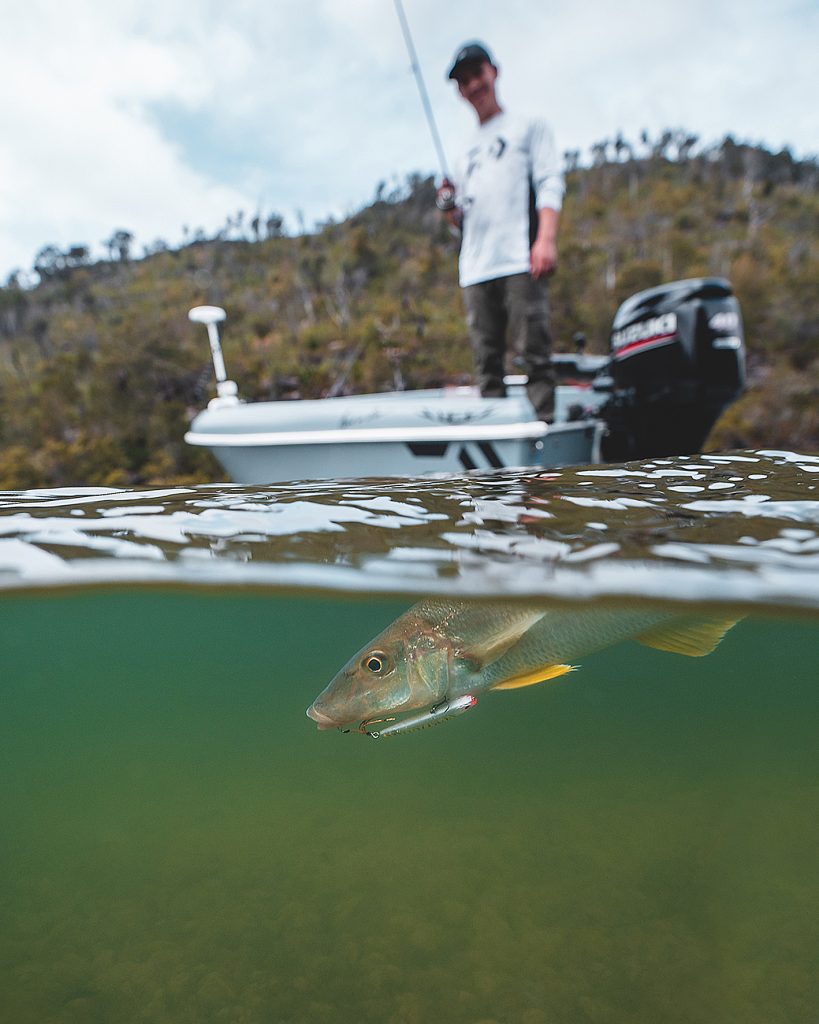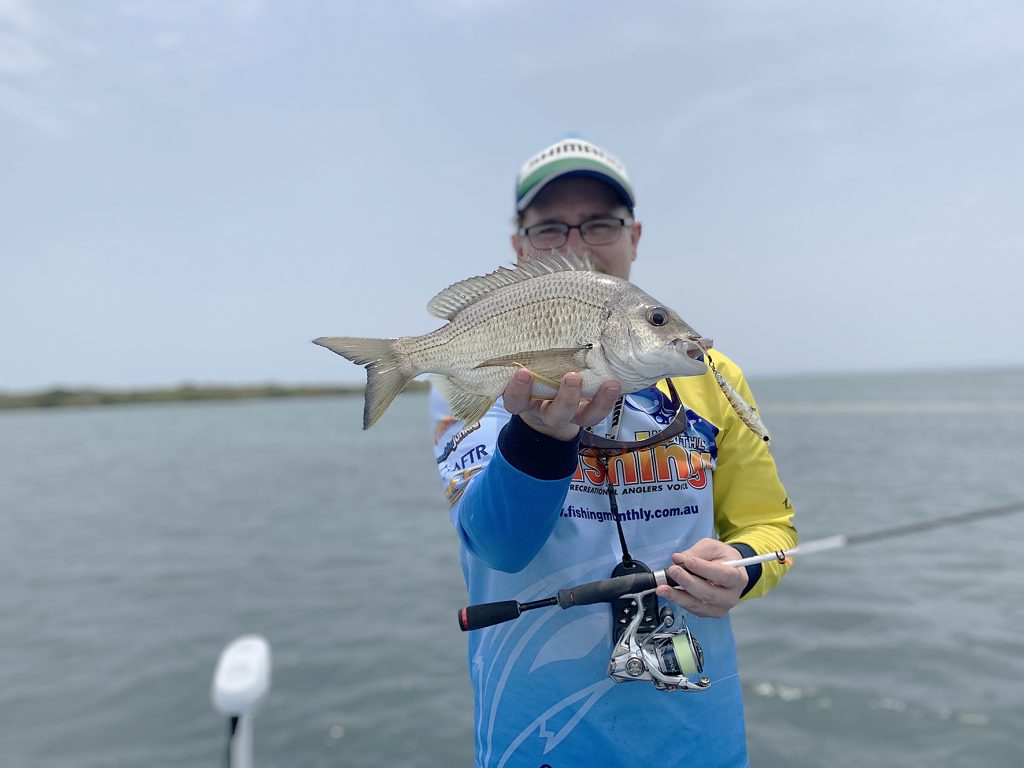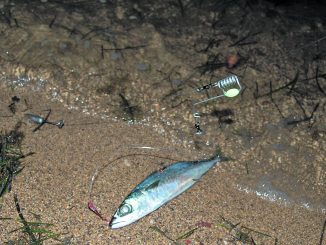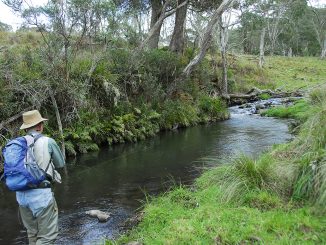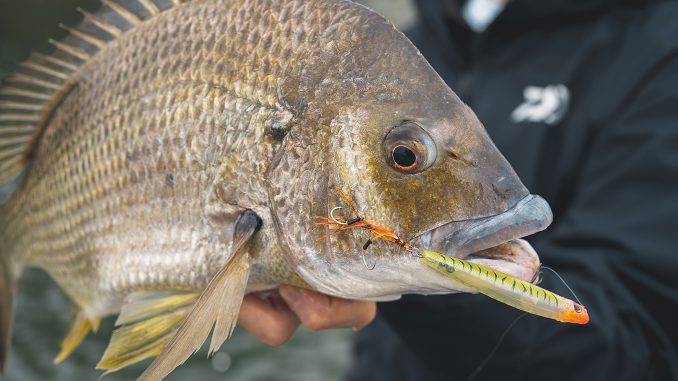
• By Robert Thornton
Throughout their range, yellowfin bream are a challenging but reliable adversary year round, with summer and autumn being the pick for topwater action.
During this time, prawns of various species make their way down rivers and creeks, usually assisted by the extra fresh pumping through these systems. These nervous morsels eventually take up residence in the estuary. Down in this more saline water, they are an important food source for many hungry critters, with yellowfin bream being just one of their regular tormentors!
At the same time, heightened insect activity sees food falling from above. Crawlies such as cicadas, dragonflies, butterflies and beetles are all on the yellowfin menu.
FIND THE FOOD
As with most fishing, finding the food source is critical to success, and there are things you can look for to get you into the action faster.
Generally speaking, this fishing is done in sheltered salt or brackish waters, and it’s usually not difficult to find suitable habitat. Mangrove creeks, sandy inlets, small sheltered islands and even heavily built-up canals will all harbour the soft, squishy baby prawns (often called jelly prawns) and flying insects that bream love to chomp.
Heavily built-up areas like canals and rivers running through major cities and towns will probably be heavier on the prawns, while brackish creeks with thick native vegetation hanging over the water will likely offer more in the way of insects, so adjust your approach accordingly. We will discuss presentations later on.
In any case it pays to be observant, and luckily with bream, their feeding behaviour is often very obvious and doesn’t require expensive technology to reveal. When motoring through mangrove creeks on hot summer days you’ll often hear that tell-tale surface sucking sound from feeding yellowfin. This exaggerated kissing sound indicates that there is at least one bream – and more likely a group of bream – chasing food in the shallows.
Speaking of the shallows, this is where the vast majority of topwater breaming happens. Prawns and other crustaceans like to push up shallow into nutrient-rich mangrove forests where they can feed, with the shallows providing some safety from their hungry assailants. I say ‘some safety’ because bream are determined little customers, and will push up super shallow, sometimes turning on their side to get at a few tasty prawns.
Insect activity is usually linked to vegetation, which grows on the banks lining the waterways.
Following this logic, bream seeking insects will do best under or nearby this vegetation in – you guessed it – shallow water!
In fact, I seldom venture into water more than 1ft deep when topwater fishing for bream. To a fish that often struggles to reach 40cm in as many years, deeper water is a scary place! Just like their prey, yellowfin bream spend a large portion of their life escaping the jaws of predators. This is why I never shy away from exploring the shallowest margins in search of these little battlers.
TOOLS OF THE TRADE
There are people who spend a mint in pursuit of bream, and I believe that with the amount of technique specific equipment available now you will have a huge advantage if you spend a little extra. You can, however, still catch plenty of topwater bream using mid-range and even cheap gear. What matters more is that you apply what knowledge you have built up for your chosen venue.
For rods, anything in the 1-5kg range of spin rods is perfect. Major brands such as Atomic, Daiwa and Shimano actually build rods specifically for topwater bream fishing. These rods are usually around the 6-7’5” range and are relatively soft, which helps keep tiny trebles and assist hooks pinned while fighting fish.
Spin reels in the 1000-3000 size range are standard for yellowfin bream, and I believe that light braided lines are the way to go for topwater breaming. There are anglers who like to use fluorocarbon straight through, and I have done this when employing other techniques for bream. The reason I don’t like using straight through fluorocarbon for surface work is that braid floats, while fluorocarbon sinks. Braid allows long, accurate casting under pontoon walkways or overhanging mangroves. Braided lines between 2-6lb will handle most bream swimming.
A good rod length of monofilament or fluorocarbon leader is fine, and my choice of leader material depends on my choice of lure. Fluorocarbon, which usually sinks, is helpful when using lures that need to be pulled under the water momentarily to achieve their optimum action. Bent minnow design lures, fizzers and some poppers work best when they are stabbed under the surface and allowed to float back up. Having the trace sink in front of the lure a little bit can help you get the most out of these retrieves. Fly fishers who want their surface flies to ‘dive’ should also use a fluorocarbon tippet.
If I want my lure to stay on the surface and not get pulled under by the leader, monofilament is a better option. Presentations such as stickbaits and surface crawlers definitely work better with monofilament leaders.
Leaders should be a similar poundage to mainlines, with 2-6lb being a good range, although I have ended up in proper Jurassic bream country where 12lb leaders were standard, so it always pays to have something heavier in your arsenal as well!
LOADING UP ON LURES
Some anglers literally do load up on small topwater for this caper, because it is just so much fun! It’s possible to spend thousands of dollars filling plastic boxes with jelly prawn and insect imitations, and the nice thing is that these same presentations will be snapped up just as readily by whiting, bass, mangrove jack, trout, sooty grunter, jungle perch and many others.
True to my usual form though, I’m always looking for ways to do things cheaply, and smart bream anglers can do the same.
When imitating prawns, which can range from small rice grain-sized juveniles to banana-length adults, stickbaits, bent minnow styles, poppers and fizzers will cover your bases. Anything that ‘spits’ water as it is worked across the surface is perfect for replicating the panicked fleeing of a prawn, something yellowfin bream are wired to zero in on!
If you find yourself a little further up the system where insects dominate the menu, lures such as cicada imitations, poppers and fizzers made to look like grasshoppers, bass flies such as Dahlberg Divers and Muddler Minnows, and even lightly-rigged soft plastics worked along the surface work great.
Hook configurations are an interesting point of discussion amongst bream anglers. Small trebles are fairly standard on most lures, and size 10-16 is a good range to have on hand.
Retro-fitting assist hooks to lures has become common practice in bream circles in recent years, and these hooks are particularly handy when bream are short striking, which they often do.
I have had success using ‘W’ style or double hooks, rigged with the two hook points facing backward. A configuration like this is at its best when fishing amongst thick mangroves with lots of roots just under the surface. Rigged like this, lures will tend to ride over structure and not get hung up as often.
If you do want to retro-fit your own hooks, make sure you test the lure out before you fish with it. With such small lures, such a minuscule change in the weight distribution can affect the action of the lure very easily – sometimes for the better – but it pays to be in tune with your lures!
Knowing which presentation to apply in different environments is important to success, so let’s look at a few common scenarios.
ON THE WATER
Canals
Canals are a classic environment for feeding bream at any time of the year, however during summer and autumn when there is more rain, prawns make up a large part of a yellowfin bream’s diet. Jelly prawns will seek shelter in the shallow water under or behind pontoons and jetties, and casting realistic presentations to these areas can see packs of silver gluttons shouldering one another for the first shot.
At higher stages of the tide, prawns will push back into the shallowest water possible, often behind structures such as pontoons, rock bars and walkways. Up in these areas they have a better chance of escape, and they can feed on the nutrients that rainwater and consistent sunlight provide. The bream, of course, will follow them into the shallowest margins.
As the tide drops, bream and their prey will fall back into the deeper holes, and will often sit under any structure that still has water in it. In canals everywhere, layers of scum and debris will collect at the dead ends, and these clumps of matter, often made up of leaf litter, dust, oil and rubbish will often have prawns and bream sitting under them. They are brought up by the tide, and given the lack of current at the back end of canals, they can stay in these areas for a long time. If you find one of these curious phenomena, it’s always worth a cast or two.
Bridges will also see prawns seeking shelter from the current around the pylons, and these can be hotspots for bream. Working your way along the bridge, methodically fishing your topwater presentations as close to each pylon as possible, can be very satisfying. Sometimes there’s bream on every pole!
Moored boats and virtually any floating artificial structure shouldn’t be ignored. If you notice activity in these areas, it makes sense to offer a few speculative casts as you move by.
Flats
Sand and rubble flats are another productive arena for topwater enthusiasts. Flats that don’t get more than 1ft of water over them at high tide, with a good amount of current and at least the odd piece of structure in the way of rocks, coral, weed or dead wood, are perfect. Prawns will end up in these areas, and make for a relatively trouble-free fishing experience, as there’s no tricky underarm casting required to get at the fish.
It’s not all smooth sailing though, as the open nature of these environments tends to make bream more wary than usual. Bream are constantly on the lookout for birds and bigger fish when out in exposed areas like this, and will scatter at the first sign of danger.
For this reason, it’s important to be as quiet as possible, which means treading quietly if you’re wading, and keeping your electric speed low if you’re in a boat. Long casts with small, translucent presentations are the key to success, and if you can get the wind at your back, even better!
A handy hint if you’re finding the action a little slow on the flats is to switch to a straight-through fluorocarbon rig. This is the only scenario where I prefer fluorocarbon to braid while topwater fishing. The nervousness of the fish can sometimes be such that your braid – which casts a clear shadow when the bottom is 30cm away in full sunlight – can alert their already heightened senses. Fluorocarbon, on the other hand casts minimal or no shadow. Steve Morgan taught me that!
Fishing in these areas, anglers will often run into trophy summer whiting. If you notice whiting chasing your lures and you want to catch them, employing a fast, constant retrieve rather than the stop-start cadence of a bream retrieve could see a few tasty whiting fillets in the bag!
Mangrove Creeks
Getting up into the mangroves isn’t always a pleasant experience. Mosquitoes, oppressive humidity, and the constant threat of snagging makes it a challenging arena to fish, but this is where some of the best topwater bream fishing can be had!
Juvenile prawns, which seek food, shade and safety, can find all of these things in the mangrove forests, but when the tide rises high enough, yellowfin bream will venture into these zones in search of a feed too!
From above, insects such as cicadas and beetles will also be clumsily going about their business, providing a smorgasbord for the hungry bream.
Tide is very important when fishing the mangroves, as many mangrove forests will only have water through them at the highest stage of the tide. At low tide, the prawns can hole up in puddles and even settle into the mud, however as the water floods into these areas bream will take their chance to score a feed. The water may only be up there for an hour or so, meaning your timing is critical.
Casting your lures into mangrove habitats with 1ft or less of water through them is a great way to find hungry bream. These fish are up there for one reason, and that reason is food, so they are generally quite willing to chase down topwater lures.
Given the abundance of structure in these areas, I find these bream to be less spooky than those in more open areas. Tree cover limits shadows, and the cover that they use to hunt also helps to obscure the angler from the fish! Packs of argumentative bream will often follow a lure right back to the boat before they realise something isn’t quite right, and because bream will gather in the mangroves in big numbers, you should get plenty of chances.
GENERAL RULES
I have a few general rules when working the surface for bream. Starting with retrieves, I like to mix it up when just searching. Once I locate bream, I pay close attention to their feeding behaviour. Sometimes they smash lures without hesitation, and other times they will follow them for 20m and never look like eating them. Experimenting is the key, and sooner or later you will work out which retrieve is best on the day. If there are groups of bream chasing my lure, I’ve found that a constant retrieve will encourage at least one of them to strike, whereas a single fish will probably require time and plenty of pauses to commit.
One thing to remember is that you will miss a lot of strikes. These little fish can get a bit erratic when they sacrifice their own safety to venture out in the open to pursue something food-sized but foreign. Short strikes and misses are part of the game, but luckily they should give you plenty of chances! If one area shuts down after too many short strikes, move on to the next good bit of water.
Hooked fish can have many following fish, curious to see what the fuss is about. I have even seen them attempting to remove the lure from the hooked fish’s mouth! In this scenario, a second angler can toss a slow sinking presentation in, such as a lightly-weighted soft plastic, and in the chaos I believe it resembles a piece of flesh that has broken away; fair game to a hungry yellowfin!
If you own a boat with a livewell, boxing your fish can be a good idea. Bream are notoriously spooky, and tossing each frightened fish back to tell its friends what’s going on can put them down. Just be sure not to exceed your legal limit of bream, as live fish that you intend to release still count as fish in possession.
SCRATCHING THE SURFACE
Topwater breaming in the warmer months is a great option to have. In wet times, like those we’ve seen in the last few months, waiting for waters to clear up can be an anxious time.
Luckily, it’s after these wet times that insect and prawn activity is at its highest! And if you’re champing at the bit to fish the freshwater like I am but can’t because of flooding, the estuaries lower down will become fishable sooner after major rain events. What better way to scratch the itch?
(First published in 2022)

